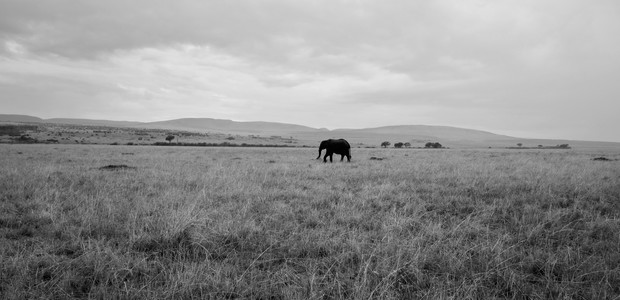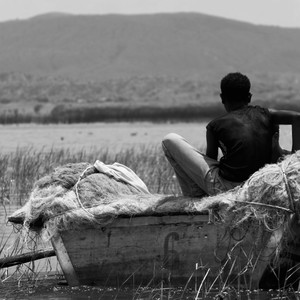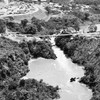A lifeline for people and wildlifeCould the Mara River disappear?

The mighty Mara River is facing ongoing environmental degradation due to human activities, in particular water abstraction by farmers and fishermen.
Winding its way through Tanzania and Kenya, the 395 kilometre-long river is one of six main inlets that drain into Lake Victoria. It originates in the Mau Escarpments in the Kenyan highlands and traverses the Masai Mara Game Reserve in Kenya and the Serengeti National Park in Tanzania before finally draining into the lake.
Known to wildlife conservationists as a “lifeline” of the world-famous national reserves, it forms different streams that feed the downstream Mara wetlands, an important source of natural resources and habitat to a variety of fauna and flora.
We’re seeing a rapid decline in the water levels.
“The wetlands play an essential role in the function and ecology of Lake Victoria and along the Nile River,” says Mwita Mataro a water protection officer at Tanzania’s Ministry of Water and Irrigation, who is based in Musoma, a town on the eastern edge of Lake Victoria.
Yet that ecology is increasingly under threat. Over 80 percent of the population that lives near the river makes their living from fishing, while many others engage in agriculture. And they have dug countless canals to trap fish or to irrigate their fields, which is causing severe environmental problems.
“Some knowingly or unknowingly abstracted the river flow to water their farm fields especially during droughts,” says Ibrahim Wabura, secretary of the North Mara Water Users Association.
The association, along with its counterpart in the south, is fighting to reverse the situation. Experts say that if it is not immediately addressed, there is a risk the river could disappear from its main path.
The association has received technical support from the Nile Equatorial Lakes Subsidiary Action Program (NELSAP), one of the two investment programmes under the Nile Basin Initiative (NBI), an intergovernmental partnership of 10 Nile Basin countries.
While fishing activities have the most impact in the northern part of the Mara Wetlands, agriculture activities and deforestation is the most detrimental in the wetlands to the south of the river.
The North Mara Water Users Association oversees the eight villages of Nkerege, Tembwi, Bisaru, Surubi, Nyamelambaro, Marasibora, Nyanchabatenye and Kwibuse, which are all adjacent to the river.
The South Mara Water Users Association is responsible for the villages adjacent to the wetlands. They include, Kirumi, Kitasakwa, Ukabwa, Ryamisanga, Kwisaro, Buswahili, Kongoto and Rwegero.
The Tanzanian government has enacted a number of laws, strategies and policies in an attempt to protect and manage its water resources. In addition, there are international treaties and conventions to which Tanzania is a signatory.
The Water Supply and Sanitation Act of 2009 criminalises any person who “wilfully or negligently misuses or wastes, or causes or allows to be misused any water passing into, through or upon, or near any waterworks”.
Water is regarded as vital in enabling Tanzania to achieve its social and economic objectives, known as the “Development Vision 2025”. These include eradicating poverty, attaining water and food security, and sustaining biodiversity and sensitive ecosystems.
The revised “National Water Policy” and subsequent reviews and reforms of existing laws, institutional frameworks and structures are all aimed at meeting these objectives.
However, deforestation, agriculture activities and other economic activities, including mining and fishing, are having a huge toll on this sub-basin of the greater Nile River Basin.
“Human activities in the basin have seriously affected us,” says Mairi Magabe, chairperson of the South Mara Water Users Association. “Floods occur even at the slightest downpour.”
“We’re seeing a rapid decline in the water levels,” Magabe said. “There is a big difference when you compare it to 10 years ago.”
Magabe says that as well as the declining water levels, the river alongside the protected wetlands is witnessing a rapid extinction of various species including trees and fishes.
Residents and local leaders say that the increased fishing activities in the form of canals have led to the removal of most of the tree species that could have prevented the flooding. The Buhemba gold mine is also blamed for contributing to deforestation in the protected area.
“We managed to control the speed and now people are helping by planting more trees,” Magabe said. “However it is not up to the required pace.”
Wabura, secretary of the North Mara Water Users Association, told The Niles that a number of log trees that were illegally cut down had been washed away by the rains and subsequently clogged the river.
At the border of the Busaru and Surungu villages huge logs had caused the river to become diverted. The gaps have been filled by sand, which then poses a risk for crocodiles moving from one point to another.
A local leader and mother of five in Busaru village says it has been many years since the villagers last spotted crocodiles. She says there are places along the river where before, residents had to use canoes to cross the river but now it is dry and people can just walk.
“The crocodiles helped to clear the river and allow a smooth water flow,” Wambura explained. While the two associations were working at decreasing the level of human activities along the wetlands and the water sources, they have limited resources.
Despite covering a large area the associations have no permanent office or transport facilities to help survey the area. Furthermore, for a long time the associations weren’t recognised by the local government authorities.
Amani Ngusaru, World Wide Fund for Nature (WWF) country director for Tanzania, says his organisation helped the associations in Kenya and Tanzania get government recognition.
“We have been training them on the climate change adaptation and sustainable land use plan. Water quality is key to humans and the wildlife,” he said.
Tampering with nature poses high risks for disasters.
According to Ngusaru, water abstraction, which is increasing at an alarming rate, must be controlled to ensure the sustainability of the Mara wetlands, Lake Victoria and the Nile.
Mark Mwandosya, a water expert and retired politician in Tanzania, says both his country and Kenya are now committed to preserving the wetlands of the Mara River Basin. However, he is worried that the two countries have no official treaties governing their shared waters, notably the Mara River.
And cooperation is vital to ensure the river survives. “We need to take precautions, rather than waiting to see a similar experience with the Great Ruaha River,” Ngusaru of the WWF said.
Since 1993, that river has regularly dried out, sometimes for months at a time. Experts have concluded that this was largely due to farmers diverting the river for irrigation purposes, as well as deforestation. “Tampering with nature poses high risks for disasters,” Ngusaru said.





